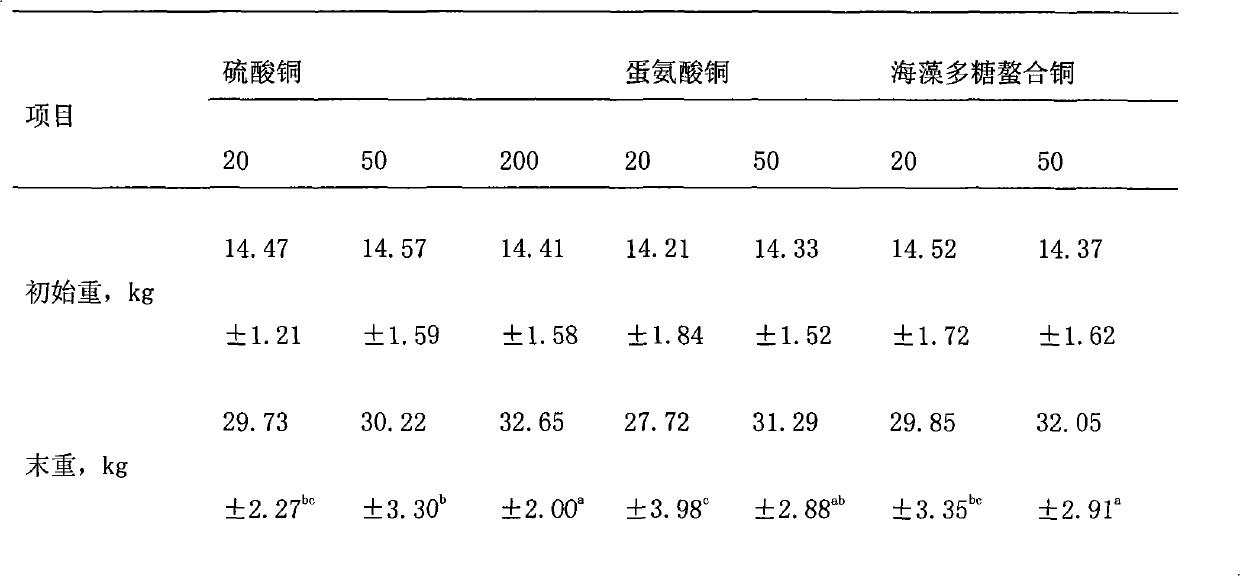Preparation method and application of low-molecular weight seaweed polysaccharide trace element chelate
A technology of seaweed polysaccharides and trace elements, which is applied in the fields of application, animal feed, animal feed, etc., can solve the problems of difficult promotion and application, waste of resources, and a large amount of waste residue, and achieve the goals of improving bioavailability, reducing emissions, and reducing additives Effect
- Summary
- Abstract
- Description
- Claims
- Application Information
AI Technical Summary
Problems solved by technology
Method used
Image
Examples
Embodiment 1
[0012] Embodiment 1 prepares low-molecular seaweed polysaccharide chelated copper feed additive
[0013] Weigh 10Kg of dried brown algae, pulverize it, add it into 80L of water according to the ratio of material to liquid 1:8, stir evenly, add 0.5Kg of compound enzyme preparation (protease, dextranase), pH5, react at 45°C for 8 hours, 105 ℃ inactivation for 30min. Add 0.5M sulfuric acid solution, react at 90°C for 1.5 hours, neutralize with 1.5N NaOH solution to pH7, filter with a ceramic microfiltration membrane with a cut-off molecular weight of 50,000Da, remove macromolecular polysaccharides with a molecular weight greater than 50,000Da, and then filter with a cut-off molecular weight Concentrate and desalt for a 1000Da ultrafiltration membrane to obtain the desired low molecular weight seaweed polysaccharide solution.
[0014] Add 0.5M copper sulfate solution to the above-mentioned low-molecular-weight seaweed polysaccharide solution at 50°C under stirring conditions, rea...
Embodiment 2
[0016] Embodiment 2 prepares low-molecular seaweed polysaccharide chelated zinc feed additive
[0017] Weigh 10Kg of dry red algae, pulverize it, add it into 100L of water according to the ratio of material to liquid 1:10, stir evenly, add 1Kg of compound enzyme preparation (protease, dextranase, deesterase,), pH6, 45 React at ℃ for 7 hours, inactivate at 105℃ for 30 minutes. Add 1M sulfuric acid solution, react at 80°C for 2 hours, neutralize with 2N NaOH solution to pH 6, filter with a ceramic microfiltration membrane with a cut-off molecular weight of 50,000Da, remove macromolecular polysaccharides with a molecular weight greater than 50,000Da, and then filter with a cut-off molecular weight of 1000Da The ultrafiltration membrane is used for concentration and desalination to obtain the desired low molecular weight seaweed polysaccharide solution.
[0018] Add 1.0M zinc sulfate solution to the above low-molecular-weight seaweed polysaccharide solution at 50°C under stirring...
Embodiment 3
[0019] Embodiment 3 prepares low-molecular seaweed polysaccharide chelated ferrous feed additive
[0020] Weigh 10Kg of dry cyanobacteria, crush it, add it into 90L of water according to the ratio of material to liquid 1:9, stir evenly, add 0.8Kg of compound enzyme preparation (protease, dextranase), pH 5.5, react at 45°C 6 hours, inactivation at 105°C for 30 minutes. Add 0.6M sulfuric acid solution, react at 80°C for 1 hour, neutralize to pH 6 with 1N NaOH solution, filter with a ceramic microfiltration membrane with a cut-off molecular weight of 50,000 Da, remove macromolecular polysaccharides with a molecular weight greater than 50,000 Da, and then filter with a cut-off molecular weight of 50,000 Da. A 1000Da ultrafiltration membrane is used for concentration and desalination to obtain the required low molecular weight seaweed polysaccharide solution.
[0021] Add 0.2M ferrous chloride solution to the above low-molecular-weight seaweed polysaccharide solution at 60°C with ...
PUM
| Property | Measurement | Unit |
|---|---|---|
| Molecular weight | aaaaa | aaaaa |
| Molecular weight | aaaaa | aaaaa |
Abstract
Description
Claims
Application Information
 Login to View More
Login to View More - R&D
- Intellectual Property
- Life Sciences
- Materials
- Tech Scout
- Unparalleled Data Quality
- Higher Quality Content
- 60% Fewer Hallucinations
Browse by: Latest US Patents, China's latest patents, Technical Efficacy Thesaurus, Application Domain, Technology Topic, Popular Technical Reports.
© 2025 PatSnap. All rights reserved.Legal|Privacy policy|Modern Slavery Act Transparency Statement|Sitemap|About US| Contact US: help@patsnap.com


